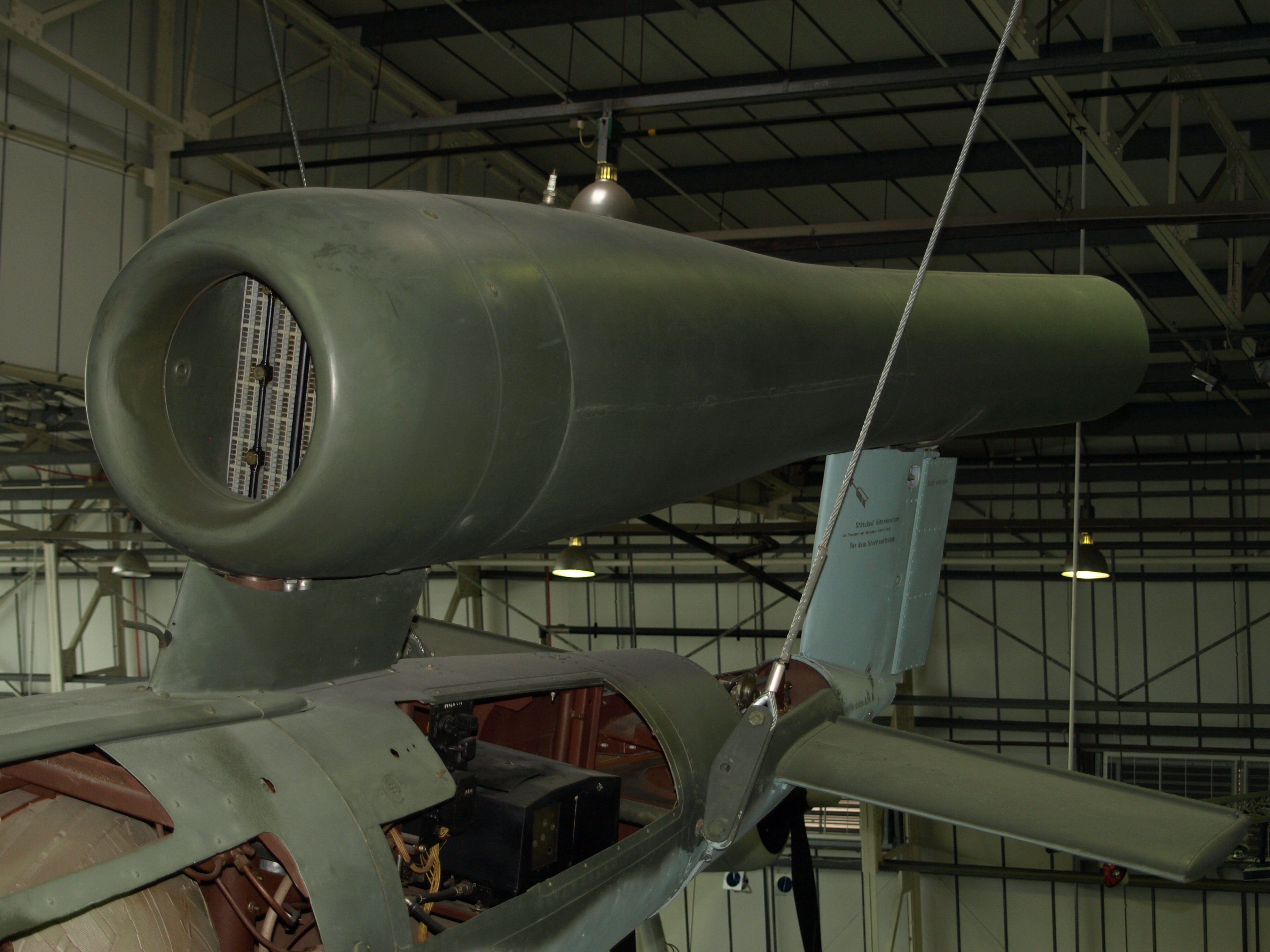 |
Pulse Detonation Engine
A pulse detonation engine (PDE) is a type of propulsion system that uses detonation waves to combust the fuel and oxidizer mixture. The engine is pulsed because the mixture must be renewed in the combustion chamber between each detonation wave and the next. Theoretically, a PDE can operate from subsonic up to a hypersonic flight speed of roughly Mach 5. An ideal PDE design can have a thermodynamic efficiency higher than other designs like turbojets and turbofans because a detonation wave rapidly compresses the mixture and adds heat at constant volume. Consequently, moving parts like compressor spools are not necessarily required in the engine, which could significantly reduce overall weight and cost. Key issues for further development include fast and efficient mixing of the fuel and oxidizer, the prevention of autoignition, and integration with an inlet and nozzle. , no practical PDE has been put into production, but several testbed engines have been built and one was ... [...More Info...] [...Related Items...] OR: [Wikipedia] [Google] [Baidu] |
|
Air Propulsion
Propulsion is the generation of force by any combination of pushing or pulling to modify the translational motion of an object, which is typically a rigid body (or an articulated rigid body) but may also concern a fluid. The term is derived from two Latin words: '' pro'', meaning'' before'' or ''forward''; and '' pellere'', meaning ''to drive''. A propulsion system consists of a source of mechanical power, and a ''propulsor'' (means of converting this power into propulsive force). Plucking a guitar string to induce a vibratory translation is technically a form of propulsion of the guitar string; this is not commonly depicted in this vocabulary, even though human muscles are considered to propel the fingertips. The motion of an object moving through a gravitational field is affected by the field, and within some frames of reference physicists speak of the gravitational field generating a force upon the object, but for deep theoretic reasons, physicists now consider the curved ... [...More Info...] [...Related Items...] OR: [Wikipedia] [Google] [Baidu] |
|
 |
Air Force Research Laboratory
The Air Force Research Laboratory (AFRL) is a scientific research and development detachment of the United States Air Force Air Force Materiel Command, Materiel Command dedicated to leading the discovery, development, and integration of direct-energy based aerospace warfighting technologies, planning and executing the Air Force science and technology program, and providing warfighting capabilities to United States air, space, and cyberspace forces. It controls the entire Air Force science and technology research budget which was $2.4 billion in 2006. The Laboratory was formed at Wright-Patterson Air Force Base near Dayton, Ohio, on 31 October 1997 as a consolidation of four Air Force laboratory facilities (Wright, Phillips, Rome, and Armstrong) and the Air Force Office of Scientific Research under a unified command. The Laboratory is composed of eight technical directorates, one wing, and the Office of Scientific Research. Each technical directorate emphasizes a particular ... [...More Info...] [...Related Items...] OR: [Wikipedia] [Google] [Baidu] |
|
Combustion
Combustion, or burning, is a high-temperature exothermic redox chemical reaction between a fuel (the reductant) and an oxidant, usually atmospheric oxygen, that produces oxidized, often gaseous products, in a mixture termed as smoke. Combustion does not always result in fire, because a flame is only visible when substances undergoing combustion vaporize, but when it does, a flame is a characteristic indicator of the reaction. While activation energy must be supplied to initiate combustion (e.g., using a lit match to light a fire), the heat from a flame may provide enough energy to make the reaction self-sustaining. The study of combustion is known as combustion science. Combustion is often a complicated sequence of elementary reaction, elementary Radical (chemistry), radical reactions. Solid fuels, such as wood and coal, first undergo endothermic pyrolysis to produce gaseous fuels whose combustion then supplies the heat required to produce more of them. Combustion is often hot e ... [...More Info...] [...Related Items...] OR: [Wikipedia] [Google] [Baidu] |
|
 |
Speed Of Sound
The speed of sound is the distance travelled per unit of time by a sound wave as it propagates through an elasticity (solid mechanics), elastic medium. More simply, the speed of sound is how fast vibrations travel. At , the speed of sound in air is about , or in or one mile in . It depends strongly on temperature as well as the medium through which a sound wave is propagating. At , the speed of sound in dry air (sea level 14.7 psi) is about . The speed of sound in an ideal gas depends only on its temperature and composition. The speed has a weak dependence on frequency and pressure in dry air, deviating slightly from ideal behavior. In colloquial speech, ''speed of sound'' refers to the speed of sound waves in Earth's atmosphere, air. However, the speed of sound varies from substance to substance: typically, sound travels most slowly in gases, faster in liquids, and fastest in solids. For example, while sound travels at in air, it travels at in water (almost 4.3 times a ... [...More Info...] [...Related Items...] OR: [Wikipedia] [Google] [Baidu] |
 |
Deflagration
Deflagration (Lat: ''de + flagrare'', 'to burn down') is subsonic combustion in which a pre-mixed flame propagates through an explosive or a mixture of fuel and oxidizer. Deflagrations in high and low explosives or fuel–oxidizer mixtures may transition to a detonation depending upon confinement and other factors. Most fires found in daily life are diffusion flames. Deflagrations with flame speeds in the range of 1 m/s differ from detonations which propagate supersonically with detonation velocities in the range of km/s. Applications Deflagrations are often used in engineering applications when the force of the expanding gas is used to move an object such as a projectile down a barrel, or a piston in an internal combustion engine. Deflagration systems and products can also be used in mining, demolition and stone quarrying via gas pressure blasting as a beneficial alternative to high explosives. Terminology of explosive safety When studying or discussing explosive ... [...More Info...] [...Related Items...] OR: [Wikipedia] [Google] [Baidu] |
 |
V-1 Flying Bomb
The V-1 flying bomb ( "Vengeance Weapon 1") was an early cruise missile. Its official Reich Aviation Ministry () name was Fieseler Fi 103 and its suggestive name was (hellhound). It was also known to the Allies as the buzz bomb or doodlebug and (maybug). The V-1 was the first of the (V-weapons) deployed for the terror bombing of London. It was developed at Peenemünde Army Research Center in 1939 by the at the beginning of the Second World War, and during initial development was known by the codename "Cherry Stone". Due to its limited range, the thousands of V-1 missiles launched into England were fired from V-1 flying bomb facilities, launch sites along the French (Pas-de-Calais) and Dutch coasts or by modified Heinkel He 111 aircraft. The Wehrmacht first launched the V-1s against London on 13 June 1944, one week after (and prompted by) Operation Overlord, the Allied landings in France. At times more than one hundred V-1s a day were fired at south-east England, 9,521 in t ... [...More Info...] [...Related Items...] OR: [Wikipedia] [Google] [Baidu] |
 |
Pulsejet
file:Pulse Jet Engine.PNG, 300px, Diagram of a valved pulsejet. 1 - Air enters through valve and is mixed with fuel. 2 - The mixture is ignited, expands, closes the valve and exits through the tailpipe, creating thrust.3 - Low pressure in the engine opens the valve and draws in air. A pulsejet engine (or pulse jet) is a type of jet engine in which combustion occurs in Pulse (physics), pulses. A pulsejet engine can be made with few or no moving parts, and is capable of running statically (that is, it does not need to have air forced into its inlet, typically by forward motion). The best known example is the Argus As 109-014 used to propel Nazi Germany's V-1 flying bomb. Pulsejet engines are a lightweight form of jet propulsion, but usually have a poor compression ratio, and hence give a low specific impulse. The two main types of pulsejet engines use resonant combustion and harness the combustion products to form a pulsating exhaust jet that intermittently produces thrust. T ... [...More Info...] [...Related Items...] OR: [Wikipedia] [Google] [Baidu] |
|
Condé Nast Publications
Condé is a French place name and personal name. It is ultimately derived from a Celtic word, "Condate", meaning "confluence" (of two rivers) - from which was derived the Romanised form "Condatum", in use during the Roman period, and thence to the French "Condé" found at various locations. It may refer to: People * Condé Montrose Nast (1873–1942), American publisher * Condé Benoist Pallen (1858–1929), American Catholic editor and author * Condé (surname) Places * Château de Condé, a private estate in Condé-en-Brie, Aisne, France Places in France that contain the element ''Condé'' * Condé, Indre, in the Indre ''département'' * Condé-en-Brie, in the Aisne ''département'' * Condé-Folie, in the Somme ''département'' * Condé-lès-Autry, in the Ardennes ''département'' * Condé-lès-Herpy, in the Ardennes ''département'' * Condé-Northen, in the Moselle ''département'' * Condé-Sainte-Libiaire, in the Seine-et-Marne ''département'' * Condé-sur-Aisne, in ... [...More Info...] [...Related Items...] OR: [Wikipedia] [Google] [Baidu] |
|
 |
Wired (magazine)
''Wired'' is a bi-monthly American magazine that focuses on how emerging technologies affect culture, the economy, and politics. It is published in both print and Online magazine, online editions by Condé Nast. The magazine has been in publication since its launch in January 1993. Its editorial office is based in San Francisco, California, with its business headquarters located in New York City. ''Wired'' quickly became recognized as the voice of the emerging digital economy and culture and a pace setter in print design and web design. From 1998 until 2006, the magazine and its website, ''Wired.com'', experienced separate ownership before being fully consolidated under Condé Nast in 2006. It has won multiple National Magazine Awards and has been credited with shaping discourse around the digital revolution. The magazine also coined the term Crowdsourcing, ''crowdsourcing'', as well as its annual tradition of handing out Vaporware Awards. ''Wired'' has launched several in ... [...More Info...] [...Related Items...] OR: [Wikipedia] [Google] [Baidu] |
 |
Blackswift
The DARPA FALCON Project (Force Application and Launch from Continental United States) was a two-part joint project between the Defense Advanced Research Projects Agency (DARPA) and the United States Air Force (USAF) and is part of Prompt Global Strike. The first part of the project aimed to develop a Small Launch System (SLS) capable of accelerating hypersonic gliding weapons as well as launching small satellites into Earth orbit. The second part of the project aimed to develop Hypersonic Weapon Systems (HWS): a short term high performance hypersonic gliding weapon previously named the X-41 Common Aero Vehicle (CAV) that could be launched from Expendable Launch Vehicles (ELV), Reusable Launch Vehicles (RLVs), Hypersonic Cruise Vehicles (HCV), or Space Maneuvering Vehicles (SMP), and a long term hypersonic cruise aircraft named the Hypersonic Cruise Vehicle (HCV). This two-part program was announced in 2003 and continued into 2006. [...More Info...] [...Related Items...] OR: [Wikipedia] [Google] [Baidu] |
 |
Defense Advanced Research Projects Agency
The Defense Advanced Research Projects Agency (DARPA) is a research and development agency of the United States Department of Defense responsible for the development of emerging technologies for use by the military. Originally known as the Advanced Research Projects Agency (ARPA), the agency was created on February 7, 1958, by President Dwight D. Eisenhower in response to the Soviet launching of Sputnik 1 in 1957. By collaborating with academia, industry, and government partners, DARPA formulates and executes research and development projects to expand the frontiers of technology and science, often beyond immediate U.S. military requirements.Dwight D. Eisenhower and Science & Technology, (2008). Dwight D. Eisenhower Memorial CommissionSource The name of the organization first changed from its founding name, ARPA, to DARPA, in March 1972, changing back to ARPA in February 1993, then reverted to DARPA in March 1996. ''The Economist'' has called DARPA "the agency that shaped the ... [...More Info...] [...Related Items...] OR: [Wikipedia] [Google] [Baidu] |
 |
National Museum Of The United States Air Force
The National Museum of the United States Air Force (formerly the United States Air Force Museum) is the official museum of the United States Air Force located at Wright-Patterson Air Force Base, northeast of Dayton, Ohio. The NMUSAF is the oldest and largest military aviation museum in the world, with more than 360 aircraft and missiles on display. The museum is a central component of the National Aviation Heritage Area. The museum draws about a million visitors each year, making it one of the most frequently visited tourist attractions in Ohio. History The museum dates to 1923, when the Engineering Division at Dayton, Ohio, Dayton's McCook Field first collected technical artifacts for preservation. In 1927, it moved to then-Wright Field in a laboratory building. In 1932, the collection was named the Army Aeronautical Museum and placed in a Works Progress Administration, WPA building from 1935 until World War II. In 1948, the collection remained private as the Air Force ... [...More Info...] [...Related Items...] OR: [Wikipedia] [Google] [Baidu] |